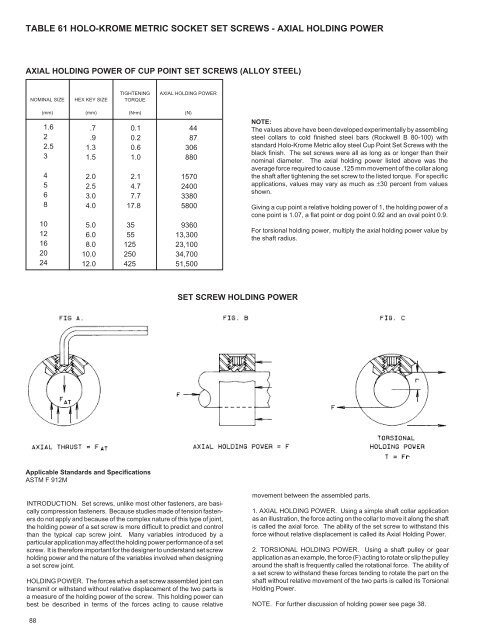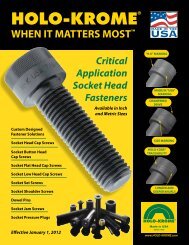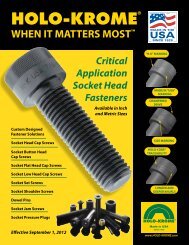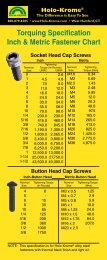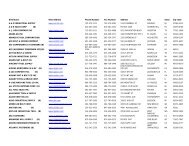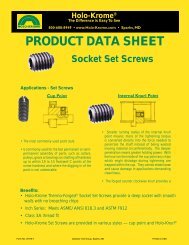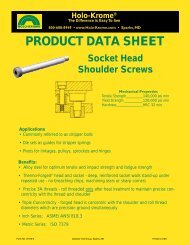Consolidated Tech Man - Holo-Krome
Consolidated Tech Man - Holo-Krome
Consolidated Tech Man - Holo-Krome
You also want an ePaper? Increase the reach of your titles
YUMPU automatically turns print PDFs into web optimized ePapers that Google loves.
TABLE 61 HOLO-KROME METRIC SOCKET SET SCREWS - AXIAL HOLDING POWER<br />
AXIAL HOLDING POWER OF CUP POINT SET SCREWS (ALLOY STEEL)<br />
NOMINAL SIZE<br />
88<br />
(mm)<br />
1.6<br />
2<br />
2.5<br />
3<br />
4<br />
5<br />
6<br />
8<br />
10<br />
12<br />
16<br />
20<br />
24<br />
HEX KEY SIZE<br />
(mm)<br />
.7<br />
.9<br />
1.3<br />
1.5<br />
2.0<br />
2.5<br />
3.0<br />
4.0<br />
5.0<br />
6.0<br />
8.0<br />
10.0<br />
12.0<br />
TIGHTENING<br />
TORQUE<br />
(N•m)<br />
0.1<br />
0.2<br />
0.6<br />
1.0<br />
2.1<br />
4.7<br />
7.7<br />
17.8<br />
35<br />
55<br />
125<br />
250<br />
425<br />
Applicable Standards and Specifications<br />
ASTM F 912M<br />
AXIAL HOLDING POWER<br />
(N)<br />
44<br />
87<br />
306<br />
880<br />
1570<br />
2400<br />
3380<br />
5800<br />
9360<br />
13,300<br />
23,100<br />
34,700<br />
51,500<br />
INTRODUCTION. Set screws, unlike most other fasteners, are basically<br />
compression fasteners. Because studies made of tension fasteners<br />
do not apply and because of the complex nature of this type of joint,<br />
the holding power of a set screw is more difficult to predict and control<br />
than the typical cap screw joint. <strong>Man</strong>y variables introduced by a<br />
particular application may affect the holding power performance of a set<br />
screw. It is therefore important for the designer to understand set screw<br />
holding power and the nature of the variables involved when designing<br />
a set screw joint.<br />
HOLDING POWER. The forces which a set screw assembled joint can<br />
transmit or withstand without relative displacement of the two parts is<br />
a measure of the holding power of the screw. This holding power can<br />
best be described in terms of the forces acting to cause relative<br />
SET SCREW HOLDING POWER<br />
NOTE:<br />
The values above have been developed experimentally by assembling<br />
steel collars to cold finished steel bars (Rockwell B 80-100) with<br />
standard <strong>Holo</strong>-<strong>Krome</strong> Metric alloy steel Cup Point Set Screws with the<br />
black finish. The set screws were all as long as or longer than their<br />
nominal diameter. The axial holding power listed above was the<br />
average force required to cause .125 mm movement of the collar along<br />
the shaft after tightening the set screw to the listed torque. For specific<br />
applications, values may vary as much as ±30 percent from values<br />
shown.<br />
Giving a cup point a relative holding power of 1, the holding power of a<br />
cone point is 1.07, a flat point or dog point 0.92 and an oval point 0.9.<br />
For torsional holding power, multiply the axial holding power value by<br />
the shaft radius.<br />
movement between the assembled parts.<br />
1. AXIAL HOLDING POWER. Using a simple shaft collar application<br />
as an illustration, the force acting on the collar to move it along the shaft<br />
is called the axial force. The ability of the set screw to withstand this<br />
force without relative displacement is called its Axial Holding Power.<br />
2. TORSIONAL HOLDING POWER. Using a shaft pulley or gear<br />
application as an example, the force (F) acting to rotate or slip the pulley<br />
around the shaft is frequently called the rotational force. The ability of<br />
a set screw to withstand these forces tending to rotate the part on the<br />
shaft without relative movement of the two parts is called its Torsional<br />
Holding Power.<br />
NOTE. For further discussion of holding power see page 38.


